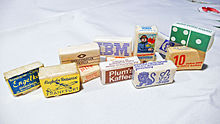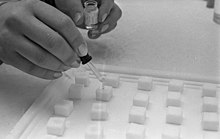Sugar cube
 From Wikipedia the free encyclopedia
From Wikipedia the free encyclopedia

Sugar cubes are white sugar granules pressed into small cubes. It is usually used by individuals to sweeten drinks. There are two main ways of using the sugar cubes: directly dissolving the cubes in the drink or placing the cube into the mouth while drinking.[1]
Size and packaging[edit]


The typical size for each cube is between 16 by 16 by 11 millimetres (0.6 by 0.6 by 0.4 inches) and 20 by 20 by 12 millimetres (0.8 in × 0.8 in × 0.5 in), corresponding to the weight of approximately 3–5 grams.[2][3] However, the cube sizes and shapes vary greatly, for example, playing card suits-shaped pieces are produced under the name "bridge cube sugar".[3]
The typical retail packaging weight is 0.5 kilogram (1 pound) or 1 kilogram / 2 pounds.[3]
In 1923 German wholesaler Karl Hellmann started packaging pair of cubes into individual wrappings with advertisements or collectible pictures on the sleeves. Originally very popular in cafés, they were quickly replaced in the beginning of the 21st century by granulated sugar in packets and sticks.[2]
Manufacturing[edit]
When making the cubes, the granulated sugar is slightly (2–3%) moistened, placed into a mold and heated so that the moisture can escape. The firmness, density, and speed of dissolution of the cube are controlled via the crystal size of the granulated sugar, amount of water/steam added, molding pressure, and speed of drying.[3] The dissolution speed is important, as the consumers that place the sugar into their mouths prefer denser, slower-dissolving sugar.[1]
The input material usually requires a wide distribution of sizes (from 500 microns and up) for the cube stability.[1]
The cubes are made on the highly automated lines capable of processing up to 50 tons of sugar per day. Typically, one of the three common processes is used[1] to produce the more popular soft cubes:[4]
- Vibro process of Swedish Sugar Corporation (from the late 1950s[4]) utilizes vibration to fill the molds and to get the formed cubes out. Heat radiation oven is used for drying;
- Chambon process was invented in France in 1949[4] and uses a rotating molding unit and a vertical dryer;
- Elba process is similar to Chambon.
History[edit]

Because sugarloafs were hard to break into manageable pieces,[4] dangerous tools were used in the process (apparently, Jakub Kryštof Rad, the inventor of the first sugar cube, started his effort after his wife hurt herself while chopping the sugarloaf).[5] The resulting pieces were irregular in size; if the piece was too large, either sugar nips had to be used, or the piece had to be dunked into the tea cup like a donut, and after sufficient dissolution taken out to dry for the next use (the latter option was described by Lev Tolstoy in his "Where Love Is, God Is": "Stepanich drank his glass, turned it upside down and set the leftover bit of sugar on it").[5]
Rad had made the first sugar cubes in the early 1840s by pressing moist sugar into a tray resembling the modern ice cube trays and letting the cubes dry. Despite Rad obtaining a patent in 1843, his business was ultimately unsuccessful.[4][6]
The next breakthrough came almost 30 years later, when Eugen Langen, of Pfeifer & Langen, used a centrifuge to produce blocks of sugar that were subsequently cut into cubes. Henry Tate (Tate & Lyle) acquired from Langen exclusive rights for producing the cubes in Britain (on 13 March 1875[7]) and started the first large-scale manufacturing of cubes.[4] Tate placed a very large bet on the innovation, temporarily running through personal financial difficulties to the extent that he had to pull his daughter from the boarding school she attended.[8] The contract with Langen involved royalties, but the factory was successful, producing 214 tons of cubes in 1878 and 1,366 tons in 1888.[9]
In 1880 Tate acquired rights to another process, invented in Belgium by Gustav Adant, where sugar "tablets" were manufactured on rotating machines and then sliced into cubes (at the time, they were called "dominoes").[4] The new process had replaced the Langen one in 1891 and was a huge success; standard quotes for refined sugar in London started to be expressed in Tate's cubes.[9]
The first process to mold cubes without any cutting was invented in Boston by Charles H. Hersey ("Hersey drum", 1879); some of these units, modified in 1929 to produce fancy shaped pieces, are still in use today.[4]
Adant's process is also still used, for example, at the Raffinerie Tirlemontoise (since 1902) to make extremely hard cubes popular in Belgium, France, and Arab countries.[4]
Use[edit]

The cubes were and are mostly used to sweeten tea and coffee (the original Rad's pieces were even sold as "tea-sugar"[4]). However, the popularity of artificial sweeteners, together with the trend of switching from filtered coffee to capuccino-like drinks, has turned sugar cubes into a niche product primarily used in bars or served at formal afternoon tea events.[4][2]
The specialty uses of cubes include:[4]
- the classical Old Fashioned cocktail recipe with a sugar cube infused with Angostura bitters;
- paraphernalia for serving the absinthe includes the slotted absinthe spoon on top of the glass. A sugar cube is placed onto the spoon and a slow drip of water dissolves the sugar into the drink, creating the desired milky louche effect[10] (a more bohemian version involves putting the soaked cube aflame[11]);
- sugar cubes can be infused with a drug, making a calibrated oral delivery simple. This was used both for administering the polio vaccine and for distribution of drugs like LSD (leaving the "cube" as a slang term for the latter);[12]
- a great variety of colored and sculpted sugar cubes (shaped as flowers and animals) is marketed in Japan.[4]
Arts[edit]
A sugar-cube metaphor is popular in architecture. First proposed by Walter Gropius in 1922, it comes back "every five years" with a variety of ambiguous meanings, from strictly regimented design (cf. works of Theo van Doesburg[13]) to "unity in variety" (cf. Italian hill towns)[14] to whitewashed plain facades of the Cyclades.[15]
A monument with sugar cube on top stands in Czech town of Dačice, the place where the first sugar cube factory was established by Rad.[6]
Multiple art galleries display the works of an Irish sculptor Brendan Jamison, specializing on the architecture-themed pieces made of sugar cubes.[4]
- Sugar cube monument in Dačice
- Houses on Kea island (Cyclades)
References[edit]
- ^ a b c d Asadi 2006, p. 455.
- ^ a b c Kirschner 2016.
- ^ a b c d Asadi 2006, p. 454.
- ^ a b c d e f g h i j k l m n Grigorieva 2015.
- ^ a b Kennedy 2012.
- ^ a b Drahoňovská 2018.
- ^ Chalmin 1990, p. 75.
- ^ Chalmin 1990, p. 76.
- ^ a b Chalmin 1990, p. 77.
- ^ Strang, Arnold & Peters 1999.
- ^ Labrecque, Warr & Labrecque 2016, p. 328.
- ^ Grigorieva 2015, p. 679.
- ^ Harbison 2003, p. 461.
- ^ Jencks 2002, p. 26.
- ^ Twardowski 2019, p. 65.
Sources[edit]
- Asadi, M. (2006). "Cube Sugar". Beet-Sugar Handbook. Wiley. pp. 454–455. ISBN 978-0-471-79098-3. Retrieved 1 October 2023.
- Grigorieva, Alexandra (2015). "sugar cubes". The Oxford Companion to Sugar and Sweets. Oxford University Press. doi:10.1093/acref/9780199313396.001.0001. ISBN 978-0-19-931339-6.
- Kennedy, Pagan (16 November 2012). "Who Made That Sugar Cube?". The New York Times Magazine.
- Chalmin, P. (1990). "Thames Refinery and the Cubes". The Making of a Sugar Giant: Tate and Lyle, 1859–1989. Harwood Academic Publishers. ISBN 978-3-7186-0434-0. Retrieved 1 October 2023.
- Kirschner, Sebastian (2 March 2016). "Die Würfel sind gefallen". Süddeutsche Zeitung Magazin (in German). Archived from the original on 5 July 2018.
- Strang, J.; Arnold, W. N; Peters, T. (18 December 1999). "Absinthe: what's your poison?". BMJ. 319 (7225): 1590–1592. doi:10.1136/bmj.319.7225.1590. ISSN 0959-8138. PMC 1127080. PMID 10600949.
- Labrecque, Lauren I.; Warr, Garret M.; Labrecque, Joseph (2016). "Absinthe: An Exploration of the Role of Mythology and Ritual in Market Revival". Celebrating America's Pastimes: Baseball, Hot Dogs, Apple Pie and Marketing?. Developments in Marketing Science: Proceedings of the Academy of Marketing Science. Cham: Springer International Publishing. pp. 325–328. doi:10.1007/978-3-319-26647-3_67. ISBN 978-3-319-26646-6. ISSN 2363-6165.
- Drahoňovská, Lucie Pantazopoulou (2018). "From Round to Square". Fehler. Goethe-Institut. Retrieved 2 October 2023.
- Jencks, C. (2002). The New Paradigm in Architecture: The Language of Post-modernism. Yale University Press. ISBN 978-0-300-09513-5. Retrieved 2 October 2023.
- Hildebrand-Schat, Viola (13 October 2022). "Sugar Cubes That Revolutionized Art: Malevich's Artistic Project as Interpreted by Leonid Tishkov in Kubvechnosti (2012)". The Mediality of Sugar. Brill Publishing. pp. 173–195. doi:10.1163/9789004513686_009. ISBN 978-90-04-51368-6.
- Harbison, Robert (2003). "The avant-garde in twentieth-century architecture". Companion to Contemporary Architectural Thought. Routledge Companion Encyclopedias. Taylor & Francis. pp. 458–461. ISBN 978-1-134-98381-0. Retrieved 2 October 2023.
- Twardowski, Mariusz (2019). "Santoryn a sprawa architektury nowoczesnej" [Santorini and the modern architecture affair] (PDF). Środowisko Mieszkaniowe (in Polish) (28). Uniwersytet Jagiellonski – Wydawnictwo Uniwersytetu Jagiellonskiego: 60–71. doi:10.4467/25438700sm.19.031.11368. ISSN 1731-2442. S2CID 213734448.
- Kaysers, Harry; Schweck, Hubert; Delavier, Hans-Joachim (1998). "Special crystal sugar products. Cube sugar, nib sugar and loaf sugar". In van der Poel, Pieter; Schieweck, Hubert M.; Schwartz, Thomas K. (eds.). Sugar Technology. Beet and Sugar Cane Manufacture. Berlin: Verlag Dr. Albert Bartens KG. pp. 962–964. ISBN 3-87040-065-X.

![House of van Doesburg [nl]](http://upload.wikimedia.org/wikipedia/commons/thumb/8/87/La_maison_Van_Doesburg_Meudon_2.jpg/120px-La_maison_Van_Doesburg_Meudon_2.jpg)
